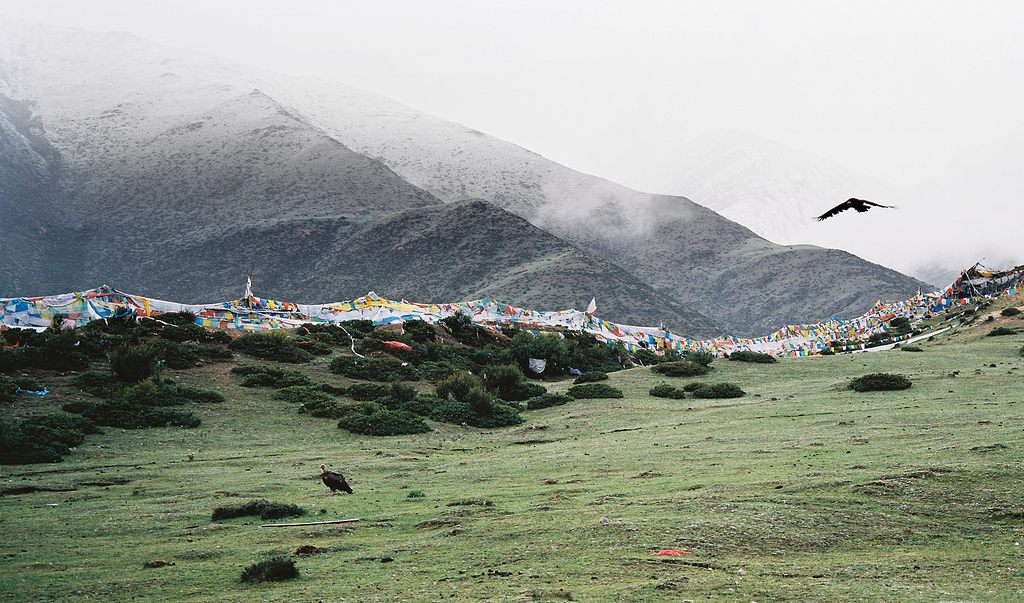The Skulls in This Wall Are All from People Consumed by Vultures
 A wall of skulls in St. Leonards Church in England (photograph by Michael Rowe/Wikimedia)
A wall of skulls in St. Leonards Church in England (photograph by Michael Rowe/Wikimedia)
Though the European bone houses are some of the most famous in the world, there are similar charnels in Asia. Located in Biru County in the Nagchu Prefacture in the Tibet Autonomous Region (TAR) is the Biru Skull Wall, or the Dodoka Skull Wall. The Biru Skull Wall is located on the grounds of the Dodoka (also Duoduoka) Monastery and contains an estimated 1,000 skulls.
The Dodoka Monastery Complex sits on an area of approximately 4,000 square meters and is comprised of living quarters for the monks, a celestial burial pool made of cobbles, a stone slab to rest corpses for sky burials — all of which is surrounded by a wall. Within the western and southern portions of the wall are charnel shelves where skulls, the remnants of hundreds of sky burials, are stored. Pictures of the skull wall can be seen here and here.
 Vulture flying at a sky burial site (photograph by Lyle Vincent/Flickr)
Vulture flying at a sky burial site (photograph by Lyle Vincent/Flickr)
During a sky burial, a corpse is arranged in a sitting position so vultures can eat the soft tissue off of the body. Once the vultures have consumed the flesh from the corpse, the monks crush all of the bones and blend them with barley flour, tea, and butter and serve them to other birds of prey. The Biru Skull Wall is unique because instead of disposing of all of the bones from the sky burial, the monks of Dodoka preserve the skulls on the charnel shelves within walls of the monastery.
There are no written records that report why the Biru Skull Wall was started or by whom. Below are a couple of the most accepted origin stories for the Biru Skull Wall.
Early in the 20th century, an eight-year-old Tibetan boy witnessed the murder of three people; the story doesn’t say whether or not the victims were family or friends to him. The little boy was so traumatized by what he had seen that he went to reside with the living Buddha at the Dodoka Monastery. After the boy became an adult, he was chosen to be the sky burial master. During the boy’s tenure he kept the skulls and put them on the shelves in the western and southern walls to ward off the murderer he saw as a child. The skull wall was left behind after his death 40 years later and maintained by his successors.
Another version states that decades ago, the living Buddha started the Biru Skull Wall as a monument to remind visitors about the impermanence of life and to inspire them to do good deeds with the time that they have.
 Biru Skull Wall (photograph via chinkayak.com)
Biru Skull Wall (photograph via chinkayak.com)
It’s believed that only three monasteries in Tibet, all in Biru County, displayed human skulls: Ridazeng, Quedai, and Dodoka. But by the early 1980s, most of the skulls from Ridazeng and Quedai had disappeared. The practice was reportedly stopped during China’s Cultural Revolution, between 1965 and 1968, but was revived by the monks at Dodoka within the last ten or so years.
The Biru Skull Wall now benefits from a “supportive governmental policy” that preserves religious relics, and the charnel attracts visitors to this remote region of the TAR.
For more fascinating stories of forensic anthropology visit Dolly Stolze’s Strange Remains, where a version of this article also appeared.
Morbid Mondays highlight macabre stories from around the world and through time, indulging in our morbid curiosity for stories from history’s darkest corners. Read more Morbid Mondays>
References:
A wall piled up by skulls. (2013). Retrieved from: http://www.chinaculture.org/gb/en_curiosity/2004-11/10/content_63052.htm
Biru Skull Wall. Retrieved from: http://www.tibetguru.com/nagqu/attractions/buri-skull-wall/
Biru Skull Wall. (2014, November 16). Retrieved from: http://www.chinatravel.com/nagqu-attraction/biru-skull-wall/
Skeleton wall: Mysterious sky burial. Retrieved from: http://www.tibettravel.org/tibet-travel-guide/skeleton-wall.html
Van Huygen, M. (2014, March 11). Give my body to the birds: The practice of sky burial. Retrieved from: http://www.atlasobscura.com/articles/sky-burial










Follow us on Twitter to get the latest on the world's hidden wonders.
Like us on Facebook to get the latest on the world's hidden wonders.
Follow us on Twitter Like us on Facebook